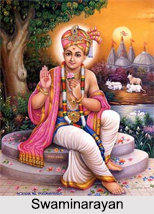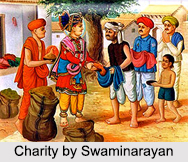 Swaminarayan, also known as "Sahajanand Swami", is the central figure in a modern sect of Hinduism known as the Swaminarayan Faith, a form of Vaishnavism. Within the faith, Swaminarayan is equated with the Supreme Being, Purushottama, or is venerated as an incarnation of Narayana from the Nara-Narayana deity pair.
Swaminarayan, also known as "Sahajanand Swami", is the central figure in a modern sect of Hinduism known as the Swaminarayan Faith, a form of Vaishnavism. Within the faith, Swaminarayan is equated with the Supreme Being, Purushottama, or is venerated as an incarnation of Narayana from the Nara-Narayana deity pair.
Life of Swaminarayan
The original name of Swaminarayan was Ghanashyam Pande. Swaminarayan was born in a Brahmin family in Uttar Pradesh in 1781 to Hariprasad Pande and Premvati Pande. Right from his early age he was spiritually inclined. At the age of 11 years, he travelled many places where he met Ramanand Swami. Swaminarayan got admission in his ascetic order known as Uddhav Sampradaya. There he received his spiritual name Sahajanand Swami. In 1802 when Ramanand Swami died, he became the head of the sect. Through his devotion he established the sect that drew many followers.
Philosophy of Swaminarayan
The teachings of Swaminarayan are regarded as qualified non-dualism or Vishishtadvaita. According to it, the one and infinite Brahmin is considered as the supreme Godhead who has several attributes and traits. He has the ability to manifest himself into five fundamental realities like the Parabrahman, Aksharabrahman, Iswara, Jiva and Maya or Prakriti. These are different modes which stand as real as a Brahmin himself.
Texts of Swaminarayan
There are many texts that were written by Swaminarayan or his followers that are regarded as Shastras or scriptures within the Swaminarayan sect. Some of the notable Texts written by Swaminarayan are as follows:
•Shikshapatri: "Shikshapatri" is a small book written by saint Swaminarayan in Sanskrit language. He wrote it in the year 1882, at Vadtal. The book includes 212 verses in Anustup Chhand and is meant to educate the monks who are part of the sect. It is equally beneficial for the common masses also.

•Vachanamrit: "Vachanamrit" of Swaminarayan is well conserved by his disciples. It has the profound wisdom of Swaminarayan on different subjects relating to renunciation, devotion, anger, lust, delusion, dharma, jiva, Ishwar, types of faith, soul and body, the form of God, tattvas, salvation and others. Some of his discourses illustrate on the ways of approaching life.
Reforms of Swaminarayan
Swaminarayan had brought about many changes in the society through his teachings and discourses. Some of the reforms by Swaminarayan are as follows:
•Reforms for Women and the Poor: Swaminarayan devoted his complete life for the upliftment of the poor and the women. After assuming the leadership of the "Sampradaya", Swaminarayan devoted himself for the poor. He distributed food and drinking water. He even constructed many almshouses for the poor. He also organized many relief projects for the people during times of drought. Swaminarayan also worked for the women. He stood against the Sati System. Swaminarayan offered parents help with dowry expenses to discourage female infanticide, calling infanticide a sin. The followers of Swaminarayan consider him as the pioneer of education of females in India.
•Animal Sacrifices and Yajnas: Swaminarayan stood against animal sacrifices that were practiced by the Brahmin priests during Vedic rituals, such as "Yajnas". To resolve the problem, Swaminarayan carry out many large scale yajnas and invited priests from Varanasi. These yajnas did not involve any animal sacrifices and were conducted in strict accordance with Vedic scriptures. Swaminarayan was thus successful in restoring Ahimsa through these large scale yajnas.
•Caste System and Moksha: It is said that Swaminarayan worked to put an end to the caste system by inculcating all into the Swaminarayan Sampradaya. He had educated his Paramhansas to collect alms from all sections of society. He dined along with the members of the lower castes. Members of the lower castes were attracted to the movement as it improved their social status. Swaminarayan dismissed the myth that Moksha (liberation) was unattainable.
Swaminarayan Sect
Swaminarayan sect is also known as Swaminarayan faith. It is a recent development in the Vaishnava denomination of Hinduism. The sect has been able to incorporate many followers who consider Swaminarayan as their God and ardently worship him. The followers strongly believe that Swaminarayan was an incarnation of Narayana who had descended on Earth to save and guide the common masses.
After the death of Swaminarayan in 1830 the sect got divided into three new groups. One group followed the Acharya system which was devised by Swaminarayan himself when he was alive. This group adopted the name "Swaminarayan Sampradaya". The second group believed that Swaminarayan himself nominated a close disciple of his in his lifetime as his spiritual successor. They consider Swami Gunatitananda as his true successor. A third group considered itself as Swaminarayan Gadi and declared Gopalananda Swami as the spiritual successor to Swaminarayan.




















